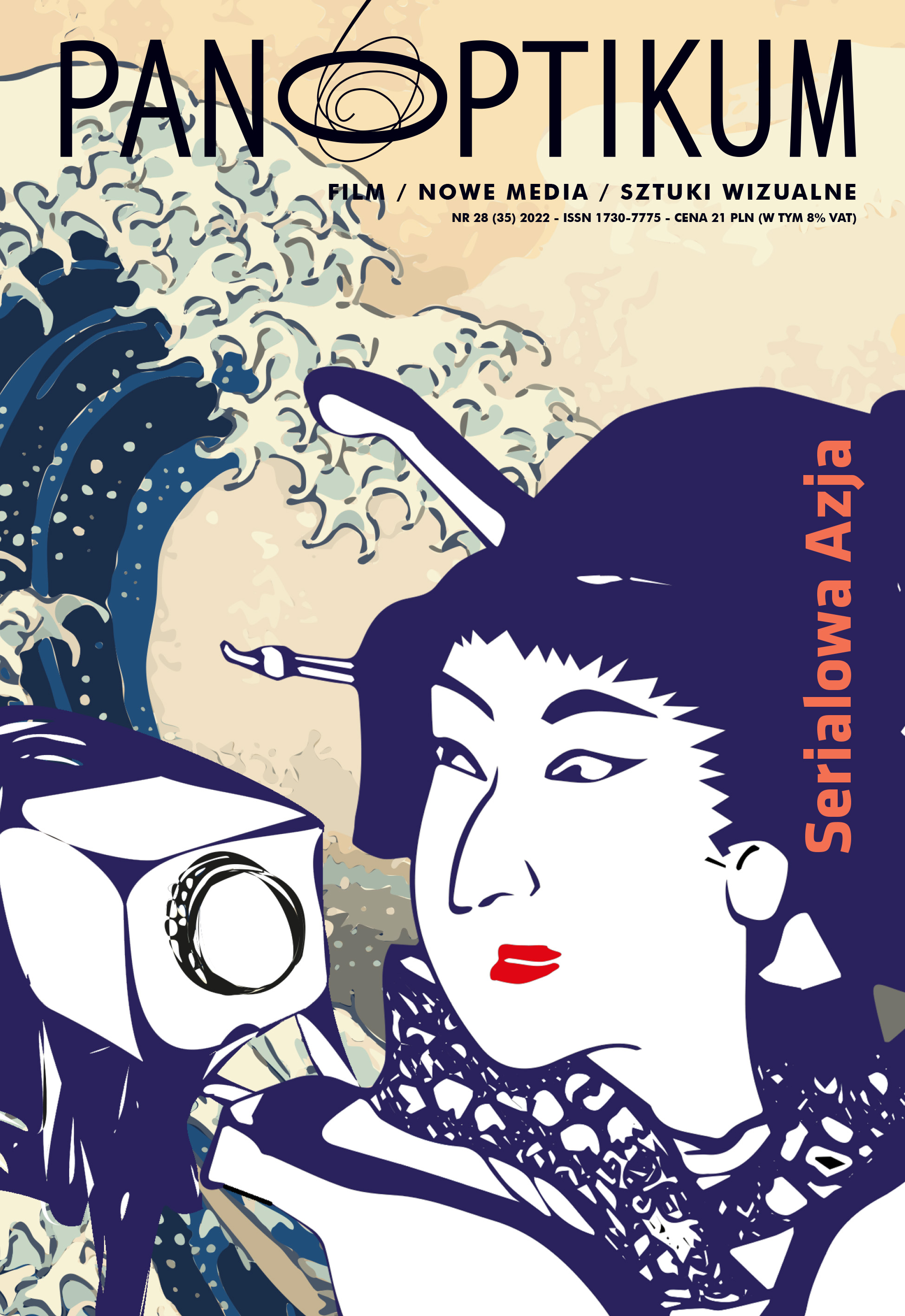Sensibilities of the digital era. New media and future technologies in K-drama subgenre narratives
DOI:
https://doi.org/10.26881/pan.2022.28.06Słowa kluczowe:
k-drama, sztuczna inteligencja, serialowe subgatunki, tropy Science Fiction, światy przyszłościAbstrakt
The presented article provides insight into the development of the SF tropes in K-dramas, pointing out the correlation between the technological discourses, narrative modifications, and the viewers’ expectations. The author focuses on three chosen titles – Crash Landing on You (Sarang-ui bulsichak), My Holo Love (Na Hollo Geudae), and Memories of the Alhambra (Alhambeura Gungjeonui Chueok) – which underline the differences between technological narratives in K-dramas. The dynamic development of K-drama subgenres indicates that the generic love story has to be accompanied by additional elements, building engaging and memorable background. There is a need for exciting surroundings transgressing the notions of probability and drifting into the fantastic or futuristic worlds. Focusing on the serialized representations of technological development, the author analyzes how K-drama anticipates the future and creates a new specter of cultural sensibilities.
Downloads
Bibliografia
Alcantud, J.A.G. (2012). Social Memory of a World Heritage Site: The Alhambra of Granada. “International Social Science Journal”, vol. 62, is. 203–204.
An, J. (2022). K-drama 2.0: Updating Tropes with Intertextuality and Cinematic Visuals in ‘Crash Landing on You’. “Journal of Japanese and Korean Cinema”, vol. 14, is. 1.
Denson, S., Leyda, J., eds. (2016). Post-Cinema. Theorizing 21st-Century Film. Falmer: REFRAME Books.
Epstein, S., Green, C.K. (2020). Crash Landing on You and North Korea: Representation and Reception in the Age of K-drama. “The Asia-Pacific Journal | Japan Focus”, vol. 18, is. 12, no. 5.
Hawkinson, E. (2022). Star Trek and the Metaverse: An Analysis of Foresight for Augmented Reality in Science Fiction. The IAFOR International Conference on Arts & Humanities – Hawaii 2022. Official Conference Proceedings. https://doi.org/10.22492/issn.2432-4604.2022.7. (access: 17.08.2022).
Jackson, A., Balmain, C., eds. (2016). Korean Screen Cultures: Interrogating Cinema, TV, Music and Online Games. Bern: Peter Lang.
Ju, H. (2020). Transnational Korean Television. Cultural Storytelling and Digital Audiences. Lanham: Lexington Books.
Kang, M. (2019). ‘My Holo Love’, The First Korean Original Series of 2020, Premieres on February 7. https://about.netflix.com/en/news/my-holo-love-the-first-korean-originalseries-of-2020-premieres-on-february-7 (access: 14.08.2022).
Kreider, T. (2002). AI: Artificial Intelligence. “Film Quarterly”, vol. 56, no. 2,.
Kim, Y., ed. (2019). South Korean Popular Culture and North Korea. New York–London: Routledge.
Kwak, Y. (2020). Netflix Series ‘My Holo Love’ Features Human-AI Romance. https://www.koreatimes.co.kr/www/art/2020/02/688_282886.html (access: 14.08.2022).
Lavocat, F. (2019). Possible Worlds, Virtual Worlds, [in:] A. Bell, M-L. Ryan (eds.), Possible Worlds Theory and Contemporary Narratology. Lincoln: University of Nebraska Press.
Lee, H. (2018). A ‘Real’ Fantasy: Hybridity, Korean Drama, and Pop Cosmopolitans. “Media, Culture & Society”, vol. 40, no. 3.
Marling, W. (2008). Mobile Phones as Narrative Tropes. “Journal of Popular Film and Television”, vol. 36, no. 1.
Misiak, T. (2010). Audiosphere in the Contemporary Culture. Attempt of Bringing Closer Notion. “Przegląd Kulturoznawczy/Arts & Cultural Studies Review”, vol. 1, no. 7.
Ong, W.J. (2002). Orality and Literacy. The Technologizing of the Word. New York: Routledge. [First published in 1982].
Pugliese, J. (2015). The Plot to Free North Korea with Smuggled Episodes of Friends. Wired. https://www.wired.com/2015/03/north-korea/ (access: 15.08.2022).
Roh, D.S., Huang, B., Niu, G.A., Roh, D.S., Huang, B., Niu, G.A. (2015). Techno-Orientalism: Imagining Asia in Speculative Fiction, History, and Media. New Brunswick: Rutgers University Press.
Rubio De Olazabal, J. (2020). South Korean Audio-Visual Production in Spain: Granada as a Ludic World in the Series Memories of the Alhambra. “Atalante-revista De Estudios Cinematograficos”, is. 29.
Shirley, P. (1979). Reviewed Work: Memories of the Alhambra by Nash Candelaria. “MELUS”, vol. 6, no. 2.
Sihombing, L., Dellavia, S. (2021). Media Framing in South Korean Drama’ Crash Landing on You’ Towards North Korea. “Journal of English Language Pedagogy, Literature & Culture”, vol. 6, no. 2.
Williams, M. (2017). All That Glitters Is Not Gold: A Closer Look at North Korea’s Ullim Tablet. 38 North. https://www.38north.org/2017/03/mwilliams030317/ (access: 15.08.2022).
Xoun, C.P., Dat, D.T., Trinh, M.N. (2022). Drama with Unique Setting and Profession Based on the Point of View of Korean Drama Connoisseurs. “Journal of Asian Multicultural Research for Social Sciences Study”, vol. 3, no. 2.
Zagalo, N., Barker, A. (2006), Television Drama Series’ Incorporation of Film Narrative Innovation: 24, [in:] A. Barker, (eds.), Television, Aesthetics and Reality. Cambridge: Cambridge Scholars Press, pp. 166–179.

 Uniwersyteckie Czasopisma Naukowe
Uniwersyteckie Czasopisma Naukowe









